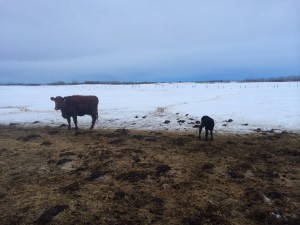Day 7
Unfortunately, cows don't calve every day, or on schedule. We went almost a week without having a calf, and then on the first day of spring, during a blizzard, 312 decided it was her turn to calve. I keep a good watch on the cows especially during inclement weather. On Thurday, I was vigilant on checking the cows every 2 hours. Wet and windy weather is the worst for newborn calves. I went out at 2:30 in the afternoon and found 312 looking like she was going to calve really soon. She ran into the catch pen, and I locked her in there so I could keep a closer eye on her. She was very nervous, so I left her so she could calm down and have her calf. I came out an hour later to check her and still no calf, but she was exhibiting signs that she had calved already, strange. I left her, though, as she was very nervous and wasn't appreciating my presence. I came back an hour later, and still no calf, so we ran her into the head catch where it's safe and easy to physically check if she has a calf in her that may be malpresented. Both my husband & I palpated her to see if there was a calf inside and nothing. We turned her back out, and later that evening we found her calf. It was where she was all day in the catch pen, but it was dead. We are still unsure what went wrong, but the signs she exhibited when I found her and when we palpated her all point to another stillborn calf.
Day 10
I came home from my weekend in Calgary for the Cattlemen's Young Leaders semi-finals, and went out to the cows immediately. While I was gone, my husband and the kids kept a close eye on the cows, but no one decided to calve. I drove around and a few exhibited signs of calving: swollen vulva, mucus, and engorged udders, but no calves. I went out a few hours later and V31 had calved a nice big red bull (boy that has not been neutered) calf. I was happy as he was up and nursing his mom.
Day 11
Again, my morning checks have been disappointing, as in no calves overnight. I noticed that S1Q was looking like she was getting close, and I was right. At my mid-morning check she had birthed a nice black heifer calf. The calf was very spry, up nursing, and already trying to buck and run. New calf coordination isn't the greatest, so she was pretty funny to watch!






